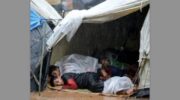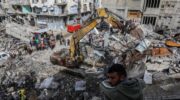\ Credit: Alex Levac
Surveillance footage shows that Yasin al-Saradih ran toward soldiers with an iron bar, soldiers shot, beat and dragged him by his limbs. It was nearly half-hour before he received medical care, eventually succumbing to his wounds. This is contrary to earlier IDF reports that al-Saradih died of smoke inhalation.
By Yaniv Kubovich and Yotam Berger, Ha’aretz
New footage of Israeli soldiers shooting and beating Yasin a-Saradih, February 22, 2018. Credit: Haaretz.com
New surveillance camera video of the shooting of a Palestinian man from the West Bank city of Jericho was posted by the human rights group B’Tselem on Wednesday. In the video, 36-year-old Yasin al-Saradih is shot before being beaten by soldiers while he laid on the ground with several soldiers surrounding him.
Al-Saradih received medical attention 20 minutes after he was shot in the stomach, beaten and dragged by his limbs. He died in custody in February. The military police have opened an investigation into the matter.
Medical sources said al-Saradih may have died from blood loss, adding that an entry hole was found in the stomach, as well as shrapnel near the tailbone, according to the results of the autopsy.
In a contrary report, the Israeli army said al-Saradih had died from smoke inhalation. According to the army’s preliminary investigation, the man ran toward the Israeli soldiers with an iron bar and attempted to grab a weapon before he was arrested.
https://youtu.be/JDcbH5bmRGw
First, Israeli Troops Shot a Palestinian Armed With a Chunk of Metal. Then, They Beat Him to Death
By Gideon Levy and Alex Levac
IDF sources maintain the soldiers didn’t notice a bullet had hit Yasin al-Saradih, and thus proceeded to ram him with their rifles, kick him in the head and drag him away.
Yasin al-Saradih’s doomsday weapon is now lying in the yard of his home on Dmitry Medvedev Street in Jericho, draped with Palestinian and Fatah flags. It is the rim of a car wheel with a pipe coming up from its center. Altogether, 25 kilos of iron, which the proprietor of the bicycle store on Moskobiya Street in the center of town usually puts outside on the street to hold a parking place for his clients. Saradih, who was 36 years old, hoisted the device onto his shoulders and ran toward the Israel Defense Forces soldiers who had invaded his city in the middle of the night, between Wednesday and Thursday last week. Soldiers raid Jericho, the most tranquil town in the occupied territories, almost every night on a pretext of “carrying out arrests.”
The same pattern was repeated last week: A few dozen soldiers from the religiously observant Lavi Battalion had entered the city center – perhaps to demonstrate a presence, perhaps to maintain operational vigilance, perhaps to haze local residents or maybe as part of their training. As far as is known, they didn’t arrest anyone. They only killed Saradih, the first fatality inflicted here by the IDF in almost 15 years.
If quiet Jericho can be ignited, too, then why not? The access road to the city is now littered with stones and scorched tires, between the casino and the hotel, two silent monuments to former dreams of peace – “Jericho first.”
The footage from the security camera that documented the events on Moskobiya Street does not make for easy watching. Saradih is seen running along the street, the tire rim on his shoulders. A soldier steps out of an alley and shoots him from point-blank range. Saradih collapses immediately after the shot, and then soldiers swarm around him, and beat and kick him all over his body. This one kicks him, another rams him with his rifle butt – they’re venting their anger, the soldiers from Lavi, the battalion that ostensibly stands for morality and lofty values.
Then they drag Saradih into the alley, like a carcass in the market. One of them continues kicking him in the head. A lynching, there’s no other word for it. Finally the soldiers are seen putting him in a military vehicle. It’s not clear how long he lay there without being given any medical aid. He may have bled to death in the vehicle.
This week we visited the spot where it all happened, together with Aref Daraghmeh, a field researcher for the Israeli human rights organization B’Tselem, who arrived at the site a few hours after the killing. He says that no bloodstains were visible at the scene of the event. Perhaps that’s why the IDF claimed initially that Saradih died from tear gas fired by the soldiers. The autopsy, however, showed that he died from a gunshot – or possibly from the combination of being shot, undergoing a vicious beating and not being given medical assistance in time. The Military Police are still investigating.
Sources in the IDF told us this week that the soldiers maintain that they didn’t know a bullet had struck their victim (even though he’d been shot from close to zero range and immediately fell to the ground), and that’s why they kicked and punched him all over. The army medical team that examined Saradih also failed to notice the gunshot wound, the sources reported.
It’s odd: The autopsy performed at the Institute of Forensic Medicine in Abu Kabir, Tel Aviv – whose results were not officially publicized – revealed an entry wound and an exit wound caused by a bullet, and also bloodstains on the victim’s hip and lower abdomen, as well as on his clothes.
The army, however, stated that he died from tear gas inhalation. The soldiers also claimed that Saradih tried to snatch the weapon of one of them after he was shot, though there is no support for this in the video footage. They also say they found a knife on him.

The IDF Spokesperson’s Unit issued the following statement to Haaretz this week: “In the wake of the incident, and because the terrorist died after he had already been detained by IDF soldiers, a Military Police investigation has been launched, in which framework the circumstances of his death are being examined. An autopsy was also performed on the terrorist’s body. In parallel, a full operational debriefing of the event is continuing.”
When the troops reached Jericho, after 1 A.M. on Thursday, a few dozen young people – about 50, according to the IDF – confronted them and began throwing stones. Only a few dozen meters separate the site of the deadly incident and the Jericho police station. But as usual, as per the occupier’s demand, Palestinian police officers were compelled to remain out of sight inside the station until things calmed down and the soldiers had gone.
A second tire rim stood on the road in front of the bike shop this week, to ensure a parking place for customers. Nearby booths were buckling under the abundance of the fruits and vegetables that paint the streets in a panoply of colors, a uniquely Jericho sight.
Before the soldiers killed Saradih, they entered the house at the far end of the same alley from which they burst out. This is the ornate, colorful home of five Barahama siblings – four sisters and their brother, all of them unmarried – and their father, Mahmoud, who’s 86. A few big white, mangy street dogs roam about in the yard.
The brother, Mohammed, arrived home after midnight that Thursday morning, and made himself a cup of coffee, Hanan, one of the sisters, tells us this week when we visit. They heard noise and then the troops arrived and entered the house, it’s not clear why. Some members of the household were sleeping. Mohammed asked the soldiers not to make noise, because their father is very ill. The soldiers searched the house and left. Naturally, they didn’t explain to anyone what they were looking for and why they appeared so late at night. “The soldiers themselves don’t know why,” one local resident suggests.
A few minutes after the soldiers departed, Mohammed saw them standing over someone who was lying on the ground at the other end of the alley. He and his sisters didn’t realize that it was their cousin, Yasin Saradih. They hadn’t heard the shot.
Medvedev Street. Opposite the victim’s home is the Russian museum that was dedicated by the prime minister of Russia, Dmitry Medvedev, when he visited the city, on November 11, 2016. The street’s name, previously Al-Jumeisi (Sycamore), was changed in honor the dignitary’s visit. A mourning notice for Yasin Saradih, who lived on the street, has now been affixed to the marble plaque commemorating the dedication. On the other side of the street is a branch of the Cairo Amman Bank.
A magnificent, ancient sycamore stands at the end of Medvedev Street, in the center of a well-tended lawn. In the absence of any other passers-by, a souvenir hawker tries desperately to interest us in the story of this amazing tree. Biblical tradition has it that this is the very same tree that Jericho tax collector Zacchaeus, who was a short man, climbed up in order to see Jesus when the latter passed throughthe city. Zacchaeus was hated in the city, because he was thought to be a collaborator with its Roman occupiers, but to everyone’s astonishment Jesus chose to stay in his house, the Book of Luke (chapter 19) relates.
Three palm trees grace the tiled courtyard of the one-story house where the bereaved family is now sitting in a circle, on plastic chairs. Their grief at the loss of Yasin is compounded by the fact that Israel has to date refused to return the body. No one can explain what prompted Yasin to hoist the tire rim onto his shoulders and run toward the soldiers. He had never been arrested. A promising soccer player on the local Al-Hilal team, his career was cut short by two incidents in which he was shot in the leg by Israeli soldiers, once in 2000 and again in 2004. The large memorial poster that hangs in the courtyard shows him in the team’s red uniform. Despite his wounds, he remained an active member of the club. During the past few years, Yasin had worked for a relative who has a store that sells dates. He never married.
The bereaved mother, Subbaiah, is 70. She has one surviving son and seven daughters; Yasin was the youngest. Her eyes are dry, she shows no outward emotion. But when we ask if she’s seen the video footage, she breaks into bitter tears. She watched the footage once, later on the same day Yasin was killed, but has not been able to bring herself to view it again. It broke her heart to see the soldiers beating her son as he lay helpless on the ground. She initially thought the soldiers had arrested him and taken him away. No one told her at first that her son was dead.
Dawn broke and he still hadn’t returned. At 6 A.M., Subbaiah went to the home of her cousins the Barahamas, to find out what happened to Yasin. He’ll be back, they told her, he’ll be back: The soldiers took him. It wasn’t until that afternoon, 12 hours after the soldiers killed Yasin, that she learned the horrific truth, from a relative. Her son Ismail says he had already heard what happened at 7 A.M., when he was at work, but didn’t dare tell his mother.
On the last evening of his life, Yasin was in good spirits, Subbaiah recalls. He went to friends around 8 o’clock to watch a soccer game on television, as he often did. She never saw him again. What made him charge at the soldiers? That will probably never be known. His mother still cannot grasp why the soldiers kicked him and why they didn’t summon an ambulance to take him to the hospital.




